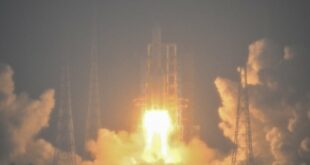Comet Nishimura, discovered last month, will be competing with the sun as it rises and sets

There's a newly discovered comet in the sky, and it's about to make its closest flyby of Earth.
Comet Nishimura (C/2023 P1) will zip past the planet at a distance of roughly 125 million kilometres today.
The comet was discovered on Aug. 12 by amateur astronomer and comet-hunter Hideo Nishimura, using his telescope in Kakegawa City, Japan, roughly 180 kilometres southwest of Tokyo.
Unlike some other recent comets, Comet Nishimura has only been visible in the pre-dawn sky rather than later at night, which has made it an early-morning catch. It is now transitioning to early-evening visibility, though it will be tricky to see as it will lie low on the horizon just after sunset.
Some early risers have managed to capture Comet Nishimura before sunrise as it has made its approach over the past few days, most of them with telescopes.
My photograph captures comet C/2023 P1 (Nishimura) above the landscape of northern Wielkopolska in Poland. Courtesy Slawomir Matz. <a href="https://t.co/npJjEkbc3w">pic.twitter.com/npJjEkbc3w</a>
—@vivstoitsis
"Goodbye Nishimura"<br>C/2023 P1 <a href="https://twitter.com/hashtag/CometNishimura?src=hash&ref_src=twsrc%5Etfw">#CometNishimura</a> 20230911T1130Z Crossfield Alberta.<br>The sad reality Comet Nishimura, is now to close to the Sun to really get any decent shots. This image was shot with a Takahashi FCT-76, Nikon D850, F4.5, ISO2000, 20 seconds. Very little post… <a href="https://t.co/R7aQwPs5XX">pic.twitter.com/R7aQwPs5XX</a>
—@theauroraguy
Some backyard astrophotography of <a href="https://twitter.com/hashtag/Comet?src=hash&ref_src=twsrc%5Etfw">#Comet</a> <a href="https://twitter.com/hashtag/Nishimura?src=hash&ref_src=twsrc%5Etfw">#Nishimura</a> ~40 mins before sunrise this AM. Stack of 15 images for denoising, shot at 200mm then cropped a bit. Pretty neat considering you can’t see any of this naked-eye <a href="https://t.co/3wSTGSm6eK">pic.twitter.com/3wSTGSm6eK</a>
—@charnick_wx
And there have also been some impressive images from astrophotographers using large telescopes.
Comet C/2023 P1 Nishimura 2023 sep. 9 2.44 UT 3x60sec 11" RASA QHY600 Michael Jäger <a href="https://t.co/xcA6BSyl1f">pic.twitter.com/xcA6BSyl1f</a>
—@Komet123Jager
Over the next couple of days, Comet Nishimura can be seen in the early morning, low on the eastern horizon, or just after sunset, low in the western sky. Starting on Thursday, it will only be visible in the evening near the western horizon.
The comet's brightness is rated around 4.0 on the magnitude scale used by astronomers, which means it is visible to the unaided eye, even in urban settings. By comparison, the full moon has a brightness magnitude of -12.6 on the scale, in which the brightest bodies in the sky have the lowest ratings, and stars that are visible only with binoculars have a magnitude of 9.5.

However, because its orbit takes it so close to the sun (as seen from Earth), the comet is difficult to spot.
"While it gets closest to Earth [today], it will be very hard to see even if [it is] fairly bright, as it will be low to the horizon from Canada just after sunset or just before sunrise," said Peter Brown, professor and Canada Research Chair at Western University's department of physics and astronomy.
"It will not be as spectacular as Comet NEOWISE [was] in 2020, and will likely be hard for the general public to see as anything except a very faint smudge."
But if you're up for a challenge, you can visit TheSkyLive.com and enter your location to see when the comet rises and sets in your area.
At the moment, Comet Nishimura is in the constellation Leo, but it will move into Virgo on Saturday. Then, on Sunday, the comet will make its closest approach to the sun: roughly 34 million kilometres away, inside the orbit of the closest planet to the sun, Mercury.
What happens then is anyone's guess: either it lives to see another orbit — roughly 400 years from now — or it could break apart.
Comet's discovery highlights amateurs' contributions
Hideo Nishimura has already helped discover two other comets: Comet Nakamura-Nishimura-Machholz (C/1994 N1) and a previous Comet Nishimura (C/2021 O1). His findings are an example of the valuable contributions that continue to be made by amateur astronomers, even though there are now several large-scale, automated sky surveys done by large telescopes around the world, such as Pan-STARRS.
There has also been some speculation that this comet may have been responsible for creating a lesser-known meteor shower called the Sigma Hybrids, which next runs from Nov. 22 to Jan. 4, and peaks on Dec. 7.
If that's true, there could be increased activity during this meteor shower's run, although there is no guarantee.
*****
Credit belongs to : www.cbc.ca
 MaharlikaNews | Canada Leading Online Filipino Newspaper Portal The No. 1 most engaged information website for Filipino – Canadian in Canada. MaharlikaNews.com received almost a quarter a million visitors in 2020.
MaharlikaNews | Canada Leading Online Filipino Newspaper Portal The No. 1 most engaged information website for Filipino – Canadian in Canada. MaharlikaNews.com received almost a quarter a million visitors in 2020.







